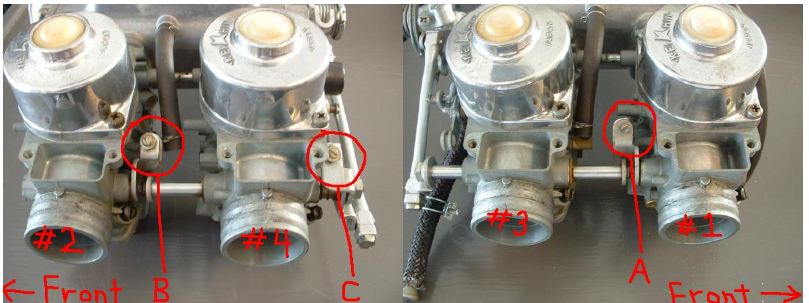I was inspired to create this Tech Tip after reading an old post by Jim Myers on the Classic Wing Club mail list. The general context of the thread surrounded the issue of setting idle mixture screws.
My view – a proper carb rebuild on a vintage ‘Wing, properly MAINTAINED should be a once-and-done proposition that gives years of reliable and trouble-free service. That’s always been my personal experience!
Otherwise, if you use inferior parts or take shortcuts – you can take advice from Alec Baldwin 
Jim Myers wrote:
“Everything effects everything….everything needs to be “close” before starting final adjustment of idle mixture and carb balance. The reason is as follows:
1. If carbs are out of balance, then the mixture is unsetable because the motor is running mostly on one or two carbs, the others are being drug along and are running very lean as a result.
2. If mixture is way off, then balancing the carbs (making the vacuum the same) will inherently make it run worse, not better.
Conclusion: Give up? Not at all, but don’t take shortcuts. This is what I do.
1. After cleaning the carbs (rebuild or whatever), “mechanically” synch the carbs. This involves looking in the carbs and either adjusting synch by visually noting the gap in the throttle plate or using a gauge pin to make sure that the carbs are mechanically in synch. This often leads to a better running engine than the vacuum method if the motor has other issues like unbalanced compression or valve issues….read on.
2. Adjust the idle mixture screws by the “turns out” method according to the manual so they are all the same.
Now you know the “system” is close to where it was designed to be. Now, use an iterative method to tweak the adjustments (meaning do idle, then balance, then idle, then balance, if necessary).
Note:
If you need to move any adjustment very far then you are actually trying to compensate for incorrect valve timing, unbalanced compression, improper ignition timing, etc. and will ultimately find yourself frustrated.
This is because if you are adjusting either balance or mixture to compensate for something else, the result of the adjustment actually yields a worse running engine.
Did I mention that everything matters?
BTW: If you still get the “high idle hang” condition, that means that the system cannot be adjusted to run at idle without having the butterflies (throttle plates) open farther than they were designed to be. This means that either the carburetor rebuild process was faulty or the compression etc. is far enough out of spec that you will not be able to compensate.”
Jim Myers – Bunker Hill, Indiana
“Synchronizing requires great precision. The underlying assumption is that your engine and carbs are in proper working order. Also, your test equipment must be very accurate to make these delicate, fine tuning adjustments. That’s why I use mercury “sticks.” If you use individual vacuum gauges, they must be carefully calibrated to each other. Otherwise, you’re wasting your time.”
Synchronizing is the very last step in a proper tune-up. As Jim wisely points out, EVERYTHING ELSE has to be perfect before you attempt synchronization.
This includes all other aspects of ignition and carburetion. Obviously, synchronizing attempts will be fruitless if there are unresolved problems like vacuum leaks. I know there is always a great temptation to rush things along and perform a synchronization to “see how she responds.” My advice: avoid this urge until you have methodically and thoroughly verified all other ignition and carburetion functions.
Sync screws are incorporated to make very small adjustments. A perfect engine with perfect carburetion and perfect ignition would not need sync screws! That’s why carbs should be bench-synced during a rebuild to get the throttle butterflies opening simultaneously. That set-up should run fairly well on any reasonably healthy engine.
Jim is absolutely correct. All performance parameters must be “close” before your begin synch attempts. If you find that need to make “big” adjustments from the “bench sync” starting point, then you are probably compensating for other problems like incorrect valve timing, unbalanced compression, poor ignition timing, etc. etc. and you will frustrate yourself.
Finally, on the issue of idle mixture screws, the idle circuits are not very sensitive on early ‘Wings. In my experience, you can usually set them to the factory setting and forget them. If the carbs are clean and functioning well, the stock setting usually yields excellent results. “Fiddling” with them further is not a high return investment of your time and effort!
Thanks to Jim Myers for permission to post the material above. Well done!
More details on the synchronization procedure here.




Anyone know of a good professional goldwing carb rebuilder for my 1983 wing?
I’m on the verge of purchasing the Master Carb kit for my ’78 GL1000. It’s in the cart, along with the Degree Timing Wheel. Thought I’d throw this out and see if anyone had ideas about what else might be the problem. I had it tuned up pretty well, running nice. Then, after mostly sitting for a while, not so good. A buddy riding with me insisted on taking the lead because he couldn’t take the exhaust fumes. Unfortunately, I have a little corrosion crack or hole in the left side exhaust just behind the driver foot peg. It literally leaks gas, at least till it gets nice and warm (a little rich, ya think?). Also, liquid gas at the end of the pipe. Had a hard time keeping it running at all. A few adjustments and now it stays running if on the side stand. When I tilt it upright, it stalls out. Any ideas?
I’m on the verge of getting your Master Carb Kit for my ’78 GL 1000, along with the Timing Degree Wheel (they’re in my cart). Wanted to see if anyone had thoughts on my issues. I had it tuned up pretty good, running well, and, after some time, things started going wrong. Here’s what I’ve got right now… Was having a tough time even keeping it running. Unfortunately, I’ve got a small corrosion hole in the exhaust on the left just rear of the rider foot peg. Well, it’s leaking liquid gas from the hole, at least till it gets good and warm. Also, have liquid gas at the end of the exhaust pipe. A little rich? Right now, I can keep it running at idle on its side stand, but when I tilt it up straight, it dies. Any ideas about where to start?
Thanks so much for this post! I’ve always been daunted by carbs, but the casualness you write with is really reassuring. The synchronizing pictures are also very helpful. Thanks so much for making repair, a DIY job, much more feasible.
Good deal. Thanks for the good feedback.
Everything Affects Everything, as well.
Yes. I was quoting another writer in this Tech Tip. Based on your feedback, I have corrected the title! 🙂